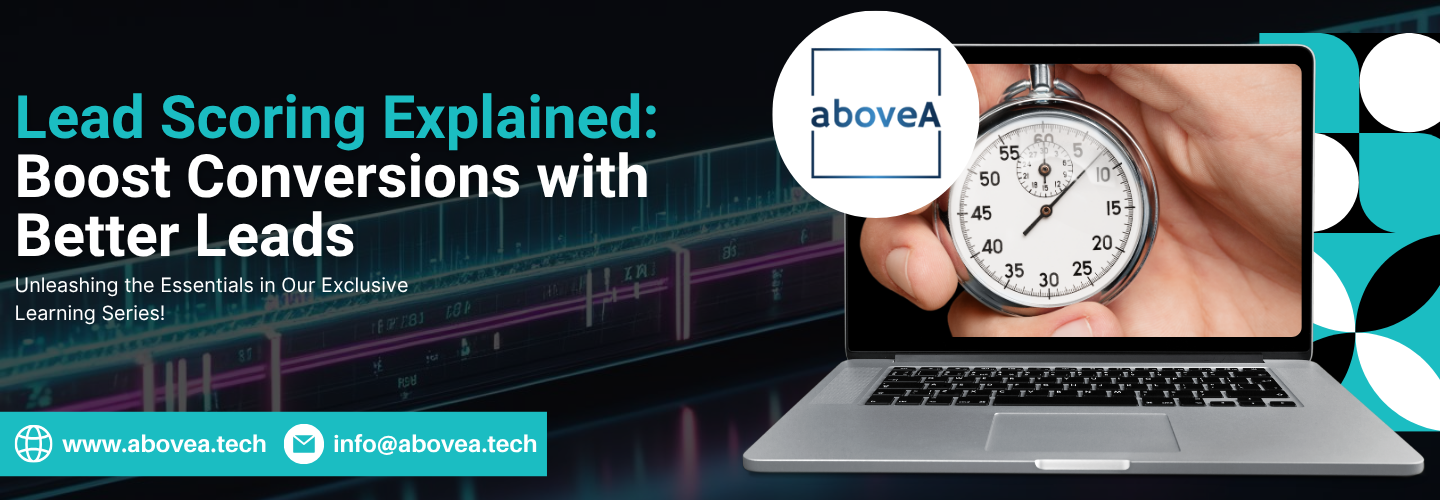
Lead Scoring: What It Is and Why It Improves Conversions?
Lead scoring helps you know which leads are worth your time as you seek to improve your conversion rate. Not all leads are ready to buy. To help you, in this guide, we will discuss what lead scoring is, how it should work, and why it can be key to improving your revenue.
Also, you will learn what makes a good score, how to build one, and the tools that can help. We will also explore mistakes you must avoid and explore some case studies. So, if you seek means to grow faster and smarter, this is your chance!
How Lead Scoring Works
Want to know how lead scoring works? It’s all about assigning points to your leads. It’s based on who they are and what they do. This scoring method will help your sales team focus on leads that are most likely to convert. It is a simple way to determine which leads have the best chance of converting.
Two Types of Lead Scoring: Fit + Behavior
In fact, there are two main types of lead scoring models: demographic (or firmographic) and behavioral. So, let’s go and explore them:
Demographic or firmographic scoring looks at lead “fit.” Is the person in the right role? Are they in the right industry or company size? For example, in B2B lead scoring, a decision-maker at a SaaS company might get +10 points, while a student from a small agency might only get +2.
Behavioral scoring measures actions. These are clues that show how interested a lead really is. Have they opened your emails? Clicked on blog posts? Downloaded a free guide? That’s what behavioral lead scoring tracks. The more they engage, the higher the score.
Manual vs. Automated Lead Scoring Models
Moreover, you can set up a lead scoring model manually or use automation tools. Manual methods work for very small teams, but they’re slow and hard to scale. Most businesses use a CRM or automation platform that scores leads in real time using pre-set rules or AI.
Example: Simple Lead Scoring Breakdown
- Email opened: +5
- Visited pricing page: +15
- Downloaded a lead magnet: +10
- Right job title: +10
- Wrong location: -5
So, when a lead hits, say, 50 points, they become a Marketing Qualified Lead (MQL).
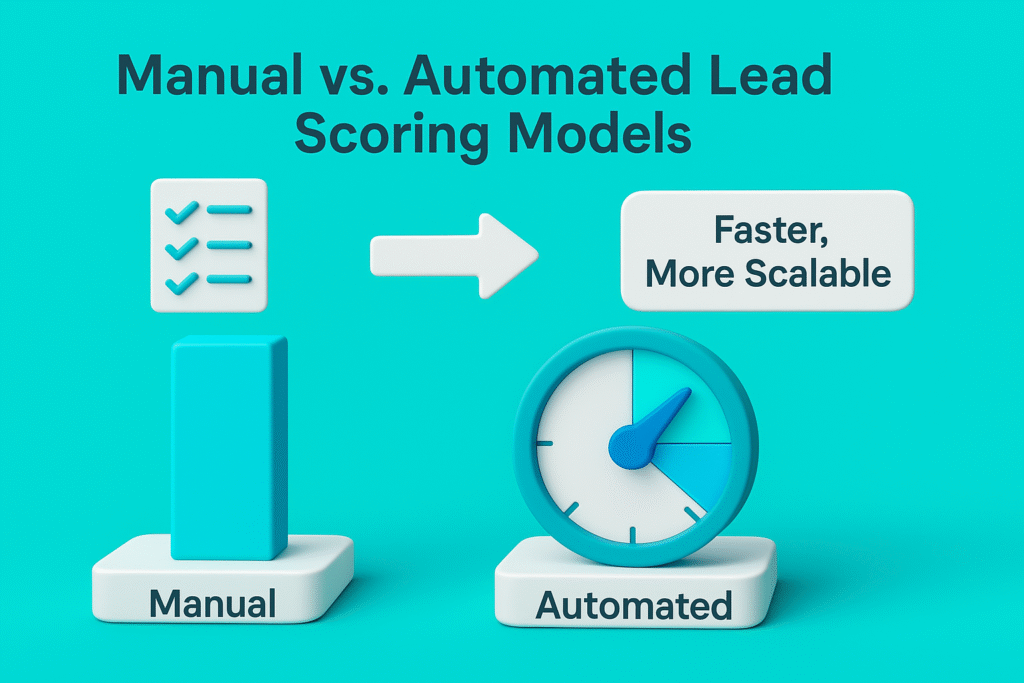
What Makes a Good Lead Score?
Let’s now talk about what a good lead score is! First of all, we treat it with clear, simple rules. Your lead score must reflect both lead qualification and how close a person is to buying. The best scores combine two key things: fit and intent.
Fit means the lead matches your ideal customer profile (ICP). Do they have the right job title? Right company size? Are they in the market you serve? These traits help you decide if they’re even worth your time.
Intent shows how much interest they’ve shown. Have they visited your pricing page? Replied to an email? Joined a webinar? These actions mean they’re not just browsing – they’re looking.
A smart lead scoring system also requires precise teamwork. Sales and marketing must agree on what a good score looks like. If one team pushes weak leads, conversions will drop. But when both sides align, your funnel should run smoothly. For example, you can try setting clear score thresholds to tell when a lead becomes an MQL (Marketing Qualified Lead) or an SQL (Sales Qualified Lead):
Criteria | Category | Score |
Job title matches decision-maker | Fit | +10 |
Company size over 50 employees | Fit | +8 |
Industry matches your ICP | Fit | +6 |
Visited pricing page | Intent | +15 |
Opened 3+ marketing emails | Intent | +7 |
Clicked on product demo link | Intent | +12 |
Downloaded an ebook or whitepaper | Intent | +10 |
Replied to an email or filled a form | Intent | +20 |
Wrong industry or student email | Fit (negative) | –5 |
No engagement in 30 days | Intent (negative) | –10 |
These checkpoints help your team take the right action at the right time. When your lead scoring reflects real value, it helps everyone win. That’s what makes a score truly great.
Tools and CRMs That Help Automate Lead Scoring
Using the right lead scoring tools makes your job easier. Instead of manually tracking every click or profile detail, you can let software do the work. Many CRMs come with lead scoring automation built in, and they’re more powerful than ever.
Here are a few top tools to consider:
- HubSpot: Offers both rules-based and predictive scoring. Easy to use and great for growing teams.
- Salesforce: Strong for enterprise B2B lead scoring. Includes AI-powered insights through Salesforce Einstein.
- ActiveCampaign: Good for smaller businesses. It scores leads based on email and website actions.
- Zoho CRM: Affordable and flexible. You can build custom scoring rules based on your sales process.
There are two types of scoring systems:
- Rules-based scoring uses fixed points for actions or traits you choose.
- AI-powered scoring analyzes patterns in your data to find the best-fit leads automatically.
Automating lead scoring brings real benefits. It saves time, removes guesswork, and reduces bias. Your team can focus on qualified leads without wasting energy on dead ends. If your goal is faster conversions, these CRM lead scoring automation tools are a smart step forward.
Common Mistakes in Lead Scoring
Even smart teams make lead scoring mistakes. One of the biggest issues? Overcomplicating the formula. If your model is too complex, no one will use it. Keep it simple and easy to follow. Another common error is not updating your scoring rules. Your business changes – so should your lead scoring model. What worked last year may not fit your current strategy.
Some teams rely on poor data or inconsistent tracking. If your CRM is missing key actions or customer info, your scores won’t reflect real interest or fit. This leads to poor lead qualification and wasted time. Finally, don’t forget the sales team. If your marketing and sales aren’t aligned, the whole system breaks. Leads might score high but still be ignored or pushed too early.
Fixing these sales misalignment issues improves results fast. Review your scoring setup often, test it, and make sure everyone’s on the same page.
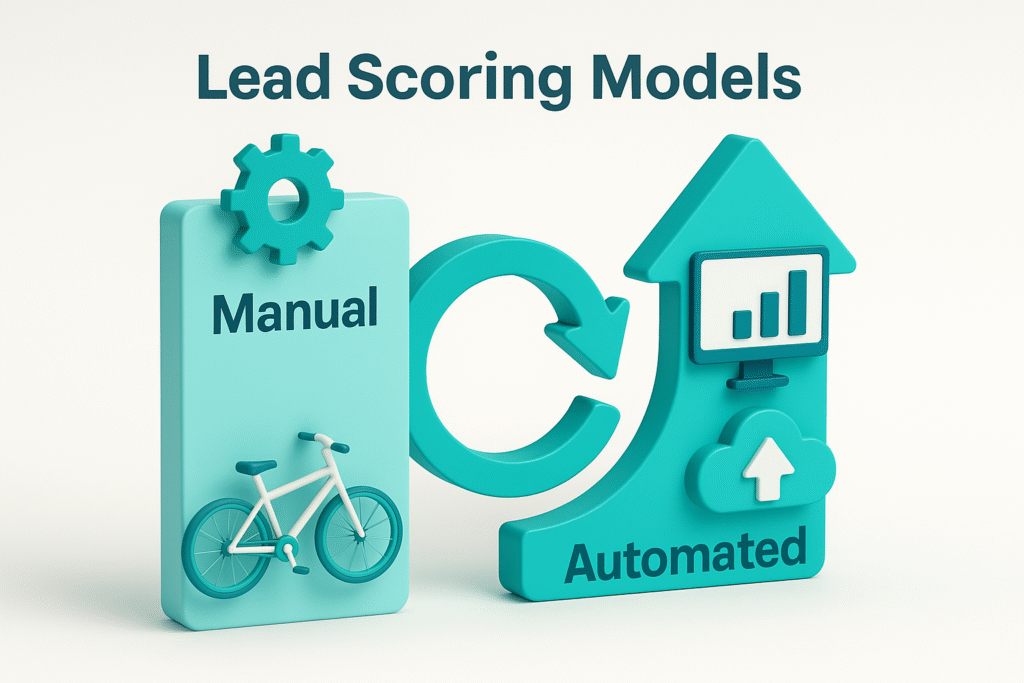
Lead Scoring in Action - In-Depth 2025 Case Studies
Here are two real 2025 case studies that showcase remarkable lead scoring success and conversion optimization, supported by source links.
1. AI-Powered Lead Scoring in Consumer Electronics, FinTech & Automotive
In 2025, businesses across the consumer electronics, FinTech, and automotive industries began integrating AI-powered lead scoring. This was done with a goal to streamline qualification processes and maximize conversion potential. A global report highlights that there was an average 45% increase in conversion rates. Also, a 30% reduction in lead-to-deal cycle time after adopting AI-driven scoring systems.
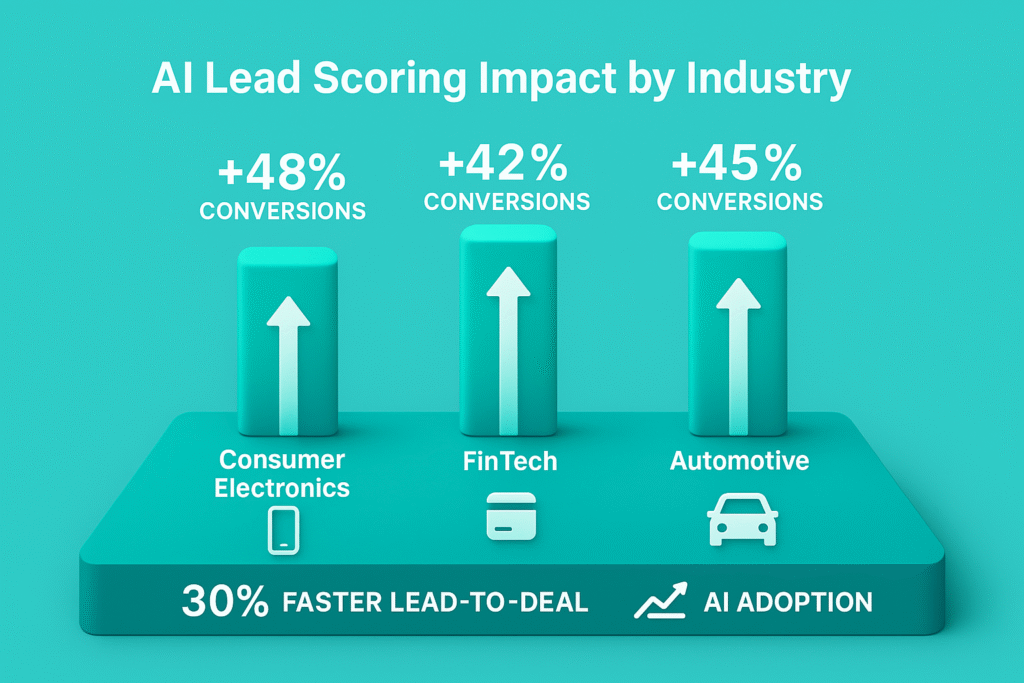
Implementation Details
In fact, these companies leveraged platforms such as Microsoft’s BEAM, SuperAGI, and Salesforce Einstein. Instead of static rule-based scoring, AI models analyzed enormous datasets, combining behavioral metrics (email engagement, site visits), firmographic traits, and third-party intent signals to generate real-time predictive scores.
A standout example involves a major consumer electronics brand issued this year by one company. Their report argued that implementing AI scoring, the team noticed that mid-tier leads with high engagement (like repeated product demo views) were outperforming traditional leads by up to 20% higher email click-through and conversion rates.
A large FinTech firm also reported a 50% uplift in lead-to-deal conversions, attributing success to AI identifying “high-intent” prospects earlier, allowing reps to prioritize fast-moving leads
That being said, what can be concluded is that AI-powered lead scoring tools are crucial for conversion optimization in high-volume industries.
2. AI-Driven B2B Lead Targeting - 30% Conversion Jump
Now, let’s take at another case study which covers a large B2B company that implemented an AI-driven lead targeting system. It helped them to capture a 30% increase in conversions.
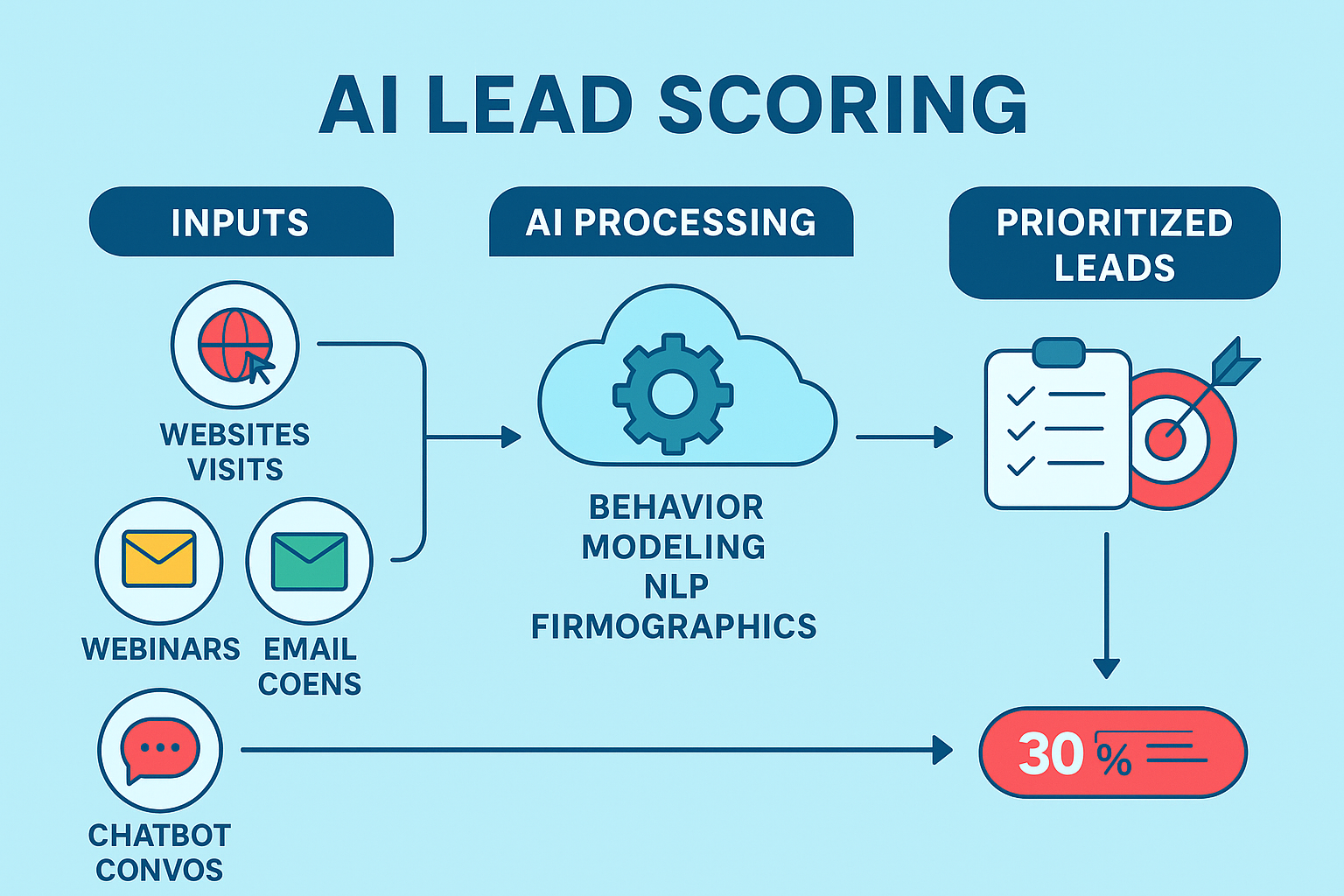
The Challenge & Solution
Facing a saturated market and extended sales cycles, the company struggled with inaccurate lead quality assessments. Traditional rule-based scoring couldn’t keep pace with dynamic buyer journeys. They turned to aboveA’s AI lead targeting solution, which blended behavioral signals, firmographic attributes, and NLP-based intent analysis to prioritize leads.
AI processed hundreds of data points – from website engagement and email activity to webinar attendance and chatbot interactions. Instead of focusing on click-based scoring, the system emphasized conversational data and expressed intent. This refined what counted as a meaningful lead.
Results Achieved
- Conversion rates increased by 30%, driven by more accurate lead identification.
- Sales teams spent less time chasing non-converting leads and focused their energy strategically.
- Enhanced lead engagement – AI-enabled personalization led to more timely and relevant outreach.
These strategies aligned sales and marketing, reduced wasted outreach, and boosted funnel efficiency.
Conclusion
This 2025 case proves that AI-powered lead scoring is not just futuristic; it’s practical. By scoring conversational intent and routing intelligently, teams can achieve dramatic conversion optimization and increase revenue performance.
Stop wasting time on cold leads. Discover how to focus on the ones that convert.
Takeaway: Start Scoring, Start Growing
The benefits of lead scoring are clear. It helps you focus on the right people, improve your follow-up, and increase conversion rates. Even a basic scoring model can bring smarter marketing and stronger sales results. You don’t need fancy tools to get started – just the right structure.
Meet the Author

Karina Kavaleuskaya
She combines a passion for storytelling with a strategic mindset to help brands grow, stand out, and connect deeply with their audiences. Through thoughtful, impactful writing, she turns complex ideas into clear, engaging narratives that drive results.

